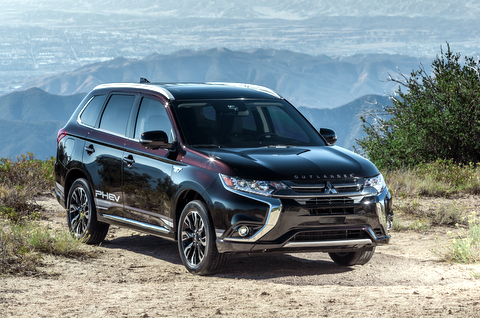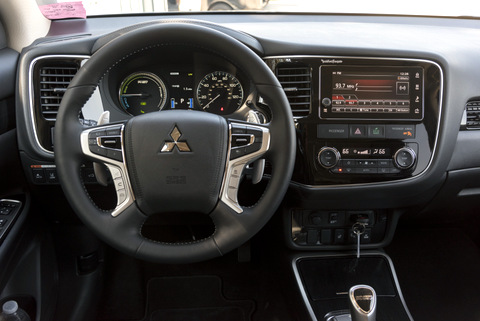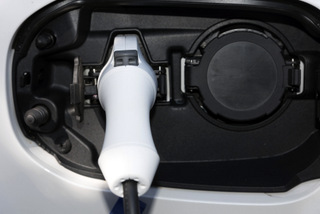Clean, Spacious, Handles Great
There are many options for plug-in hybrid electric vehicles (PHEVs) on the market, but affordable all-wheel-drive crossovers haven’t been among them—until now. Mitsubishi brings its past experience in electrification, all-wheel drive and SUVs to the new PHEV version of its Outlander.
The brand once sold the popular Montero SUV here, so it’s not new territory. This 2018 Mitsubishi Outlander PHEV has that same strong, competent feel, but now with much greater efficiency.

The drivetrain mates a 2.0-liter, 117-horsepower gasoline engine with a pair of 60 kilowatt (kW) motors. One motor is mounted up front, by the engine, while the other sits in back, below the rear cargo area. Each provides energy to its own axle, while the electric motor control unit coordinates them for effective all-wheel drive.
The system uses a 12-kilowatt-hour (kWh) lithium-ion battery, tucked beneath the floor in a sealed container between the front and rear axles. Its 80 cells supply an all-electric range of 22 miles.
Flexibility Is King
Plug-in hybrids offer more flexibility than pure electrics. I drove my 18-mile commute using almost no gasoline—on a couple of days, it was zero. My in-town errands also consumed little fuel. But if I wanted to take a long trip, I’d mostly be using the engine, which has an EPA range of 310 miles. In all situations, the motors and engine moved the 4,178-pound vehicle along without any apparent strain, and in EV mode, in blissful silence.

There are three automatic power modes. EV Drive mode is 100 percent electric, perfect for commuting and local errands. If the battery runs low, a second, Serial Hybrid mode runs the engine as a generator to charge up the battery. In Parallel Hybrid mode, the engine drives the vehicle, while the battery charges from coasting or braking, as usual. It’s ideal for most freeway cruising.
You can select other modes yourself. Eco mode reduces fuel and electricity use. Battery Save mode runs the car as a hybrid to retain battery power for later. Battery Charge mode runs the engine as a generator to add charge to the battery for either a future EV Mode drive or supplemental power for the engine for an uphill climb, for instance.
Some Good Numbers
The 2018 Mitsubishi Outlander PHEV comes with Super All-Wheel Control, an advanced system that made the Lancer such a great handling car. It’s part of what puts the car in a unique spot in the marketplace.

All electrified cars, including hybrids, PHEVs, and all-electric vehicles, use regeneration to help recharge the battery. This normally happens while coasting or braking. The Outlander PHEV offers six levels of regeneration that you can select using steering wheel paddles.
The EPA numbers are 74 MPGe for driving with battery/motors plus engine and 25 mpg with the engine only. The EPA Green scores are 7 for Smog and 8 for Greenhouse Gas.
Beyond all the tech stuff, the Japanese-built Outlander is a very pleasant place to be. The leather on the very comfortable seats was handsome, as it was on the steering wheel. The interior avoids trendy angles and edges for a satisfying, high-quality ambiance with gently rounded shapes and attractive “wood” and silvery textures.
The 7.0-inch center screen looks small by today’s standards, but works fine. The 710-watt Rockford Fosgate audio system pumped out lots of high-quality sound, controlled by steering-wheel-mounted buttons.
The Outside View
The Outlander’s exterior looks like an SUV should. The company’s latest style template means a busy chrome-trimmed front end and some fanciful taillamp iterations, but the overall shape blends in with today’s hottest trends. My Ruby Black Pearl test car wore PHEV decals and also California EV stickers, so I could ride in the carpool lane and pay half-price bridge tolls.

You have three ways to charge. Standard household current (Level 1) will do it in under eight hours, while Level 2 chargers will finish the job in less than four hours. The car comes standard with DC fast charging—and is the only PHEV on the market to have it. It’s good for 80 percent of battery capacity in about 25 minutes.
The 2018 Mitsubishi Outlander PHEV comes in two trims: SEL S-AWC and GT S-AWC. The SEL starts at $35,535, while the GT, like my test vehicle, is $41,235 (prices include shipping). My tester totaled $42,225 with a few extras, including the new paint color. The GT upgrade includes a handy multi-view camera system, sunroof and the powerful audio system.
Mitsubishi’s profile in the U.S. market has diminished in recent years as its product portfolio has shrunk. However, the Outlander, already a fine crossover, now shines as a PHEV. It combines room for five, generous cargo space, handsome styling and high efficiency. If you drive locally and charge diligently, you will enjoy an all-electric car most of the time. But since it’s a plug-in hybrid, you can take the Outlander anywhere, anytime.
In order to give you the best perspective on the many vehicles available, Clean Fleet Report has a variety of contributors. When possible, we will offer you multiple perspectives on a given vehicle. This comes under SRO-Second Road Test Opinion. We hope you’ll enjoy these diverse views–some are just below—and let us know what you think in comments below or at publisher@cleanfleetreport.com.
Road Test: 2018 Mitsubishi Outlander PHEV—John’s view
no images were found
Related Stories You Might Enjoy—Crossovers & PHEVs (rarely the twain shall meet)Flash Drive: 2019 Subaru Crosstrek PHEV
Road Test: 2018 Chrysler Pacific PHEV
Road Test: 2018 Volvo XC60 PHEV
Road Test: 2018 Kia Niro PHEV (John’s view)
Road Test: 2018 Kia Niro PHEV (Steve’s view)
Disclosure:
Clean Fleet Report is loaned free test vehicles from automakers to evaluate, typically for a week at a time. Our road tests are based on this one-week drive of a new vehicle. Because of this we don’t address issues such as long-term reliability or total cost of ownership. In addition, we are often invited to manufacturer events highlighting new vehicles or technology. As part of these events we may be offered free transportation, lodging or meals. We do our best to present our unvarnished evaluations of vehicles and news irrespective of these inducements.
Our focus is on vehicles that offer the best fuel economy in their class, which leads us to emphasize electric cars, plug-in hybrids, hybrids and diesels. We also feature those efficient gas-powered vehicles that are among the top mpg vehicles in their class. In addition, we aim to offer reviews and news on advanced technology and the alternative fuel vehicle market. We welcome any feedback from vehicle owners and are dedicated to providing a forum for alternative viewpoints. Please let us know your views at publisher@cleanfleetreport.com.
